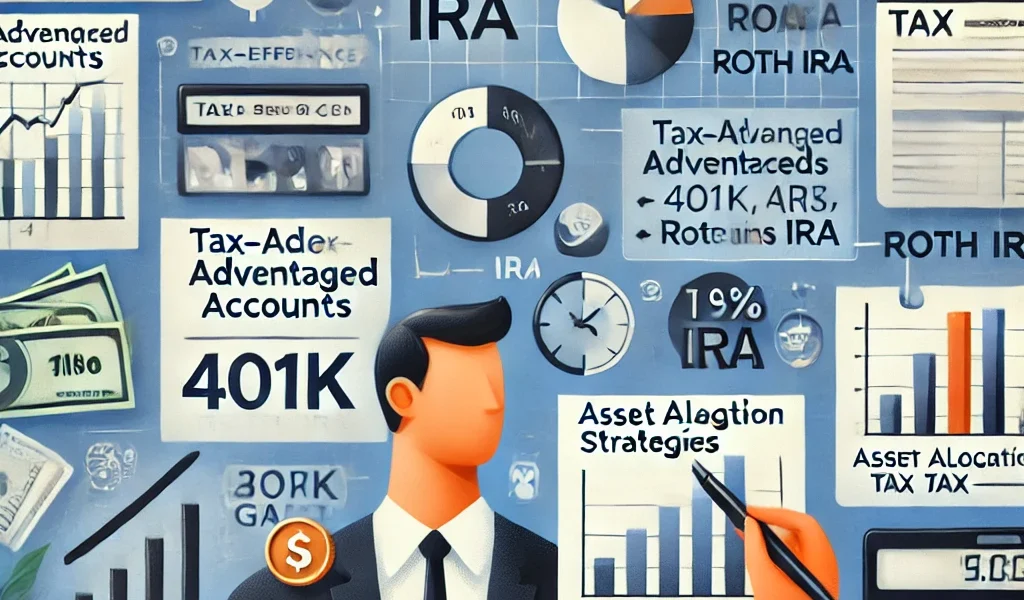Investing wisely is not just about picking the right stocks or funds; it’s also about minimizing tax liabilities to maximize returns. Tax-efficient investing allows you to grow your wealth while keeping more of your earnings. This guide will help you understand the best strategies for optimizing your investments for tax efficiency.
Understanding Tax-Efficient Investing
Tax-efficient investing involves structuring your portfolio and choosing investments in a way that minimizes taxes on capital gains, dividends, and interest income. Proper tax planning can help you legally reduce your tax burden and maximize after-tax returns.
Tax-Efficient Investment Strategies
1. Utilize Tax-Advantaged Accounts
Tax-advantaged accounts provide significant tax benefits for long-term investors:
- 401(k) and 403(b) Plans: Contributions are tax-deductible, and investments grow tax-deferred until withdrawal.
- Traditional IRAs: Contributions may be tax-deductible, and withdrawals are taxed at retirement.
- Roth IRAs: Contributions are made with after-tax dollars, but withdrawals in retirement are tax-free.
- Health Savings Accounts (HSAs): Contributions are tax-deductible, growth is tax-free, and withdrawals for medical expenses are tax-free.
2. Choose Tax-Efficient Investments
Certain investments generate lower tax liabilities:
- Index Funds and ETFs: Passive funds have lower turnover, reducing taxable capital gains distributions.
- Municipal Bonds: Interest income from municipal bonds is exempt from federal income taxes and, in some cases, state and local taxes.
- Growth Stocks: Holding growth stocks for the long term allows tax deferral on capital gains until sold.
- Tax-Managed Funds: Designed to minimize taxable distributions.
3. Strategic Asset Location
Asset location involves placing investments in the most tax-efficient accounts:
- Taxable Accounts: Ideal for tax-efficient investments like ETFs, municipal bonds, and stocks with low dividends.
- Tax-Deferred Accounts (401(k), IRA): Best for taxable bonds, REITs, and actively managed funds.
- Roth Accounts: Suitable for high-growth investments that benefit from tax-free withdrawals.
4. Tax-Loss Harvesting
Tax-loss harvesting allows you to offset capital gains by selling losing investments:
- Sell investments that have declined in value to realize a capital loss.
- Use losses to offset capital gains or up to $3,000 of ordinary income annually.
- Avoid “wash sales” by waiting at least 30 days before repurchasing the same investment.
5. Long-Term vs. Short-Term Capital Gains
Understanding capital gains tax rates can help minimize tax liabilities:
- Short-Term Capital Gains: Investments held for less than a year are taxed as ordinary income.
- Long-Term Capital Gains: Investments held for over a year are taxed at lower rates (0%, 15%, or 20%).
- Hold investments longer to benefit from lower long-term capital gains rates.
6. Dividend and Interest Income Strategies
Managing dividend and interest income can improve tax efficiency:
- Qualified Dividends: Taxed at lower capital gains rates.
- Non-Qualified Dividends: Taxed at ordinary income rates.
- Consider Dividend Growth Stocks: These often provide qualified dividends.
- Use Tax-Deferred Accounts for Interest-Bearing Investments: Bonds and CDs generate taxable interest, which is best placed in IRAs or 401(k)s.
7. Rebalancing with Tax Efficiency
Regular portfolio rebalancing helps maintain asset allocation but can create tax liabilities:
- Rebalance within tax-advantaged accounts to avoid taxable gains.
- Use new contributions to adjust allocations instead of selling existing assets.
- Utilize tax-loss harvesting to offset any capital gains from rebalancing.
8. Charitable Giving and Tax Benefits
Giving to charity can provide tax advantages:
- Donate Appreciated Stocks: Avoid capital gains tax while claiming a charitable deduction.
- Qualified Charitable Distributions (QCDs): Use RMDs from IRAs to donate tax-free after age 70½.
9. Estate Planning and Tax Implications
Proper estate planning ensures tax-efficient wealth transfer:
- Step-Up in Basis: Heirs receive investments at their market value at the time of inheritance, avoiding capital gains tax on prior appreciation.
- Gifting Strategies: Give up to $18,000 per person per year tax-free (as of 2024).
Conclusion
Optimizing investments for tax efficiency can significantly enhance your wealth accumulation. By using tax-advantaged accounts, selecting tax-efficient investments, employing asset location strategies, and managing capital gains and dividends wisely, you can minimize tax liabilities and maximize after-tax returns. Consider consulting a financial advisor to tailor a tax-efficient investment plan based on your financial goals.




